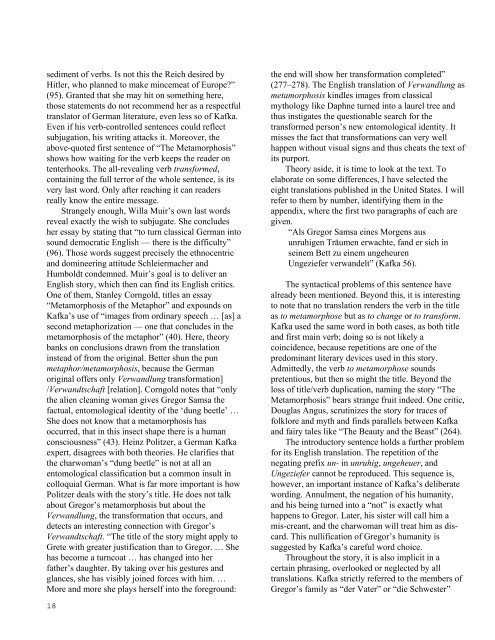their - The University of Texas at Dallas
their - The University of Texas at Dallas
their - The University of Texas at Dallas
You also want an ePaper? Increase the reach of your titles
YUMPU automatically turns print PDFs into web optimized ePapers that Google loves.
sediment <strong>of</strong> verbs. Is not this the Reich desired by<br />
Hitler, who planned to make minceme<strong>at</strong> <strong>of</strong> Europe”<br />
(95). Granted th<strong>at</strong> she may hit on something here,<br />
those st<strong>at</strong>ements do not recommend her as a respectful<br />
transl<strong>at</strong>or <strong>of</strong> German liter<strong>at</strong>ure, even less so <strong>of</strong> Kafka.<br />
Even if his verb-controlled sentences could reflect<br />
subjug<strong>at</strong>ion, his writing <strong>at</strong>tacks it. Moreover, the<br />
above-quoted first sentence <strong>of</strong> “<strong>The</strong> Metamorphosis”<br />
shows how waiting for the verb keeps the reader on<br />
tenterhooks. <strong>The</strong> all-revealing verb transformed,<br />
containing the full terror <strong>of</strong> the whole sentence, is its<br />
very last word. Only after reaching it can readers<br />
really know the entire message.<br />
Strangely enough, Willa Muir’s own last words<br />
reveal exactly the wish to subjug<strong>at</strong>e. She concludes<br />
her essay by st<strong>at</strong>ing th<strong>at</strong> “to turn classical German into<br />
sound democr<strong>at</strong>ic English — there is the difficulty”<br />
(96). Those words suggest precisely the ethnocentric<br />
and domineering <strong>at</strong>titude Schleiermacher and<br />
Humboldt condemned. Muir’s goal is to deliver an<br />
English story, which then can find its English critics.<br />
One <strong>of</strong> them, Stanley Corngold, titles an essay<br />
“Metamorphosis <strong>of</strong> the Metaphor” and expounds on<br />
Kafka’s use <strong>of</strong> “images from ordinary speech … [as] a<br />
second metaphoriz<strong>at</strong>ion — one th<strong>at</strong> concludes in the<br />
metamorphosis <strong>of</strong> the metaphor” (40). Here, theory<br />
banks on conclusions drawn from the transl<strong>at</strong>ion<br />
instead <strong>of</strong> from the original. Better shun the pun<br />
metaphor/metamorphosis, because the German<br />
original <strong>of</strong>fers only Verwandlung transform<strong>at</strong>ion]<br />
/Verwandtschaft [rel<strong>at</strong>ion]. Corngold notes th<strong>at</strong> “only<br />
the alien cleaning woman gives Gregor Samsa the<br />
factual, entomological identity <strong>of</strong> the ‘dung beetle’ …<br />
She does not know th<strong>at</strong> a metamorphosis has<br />
occurred, th<strong>at</strong> in this insect shape there is a human<br />
consciousness” (43). Heinz Politzer, a German Kafka<br />
expert, disagrees with both theories. He clarifies th<strong>at</strong><br />
the charwoman’s “dung beetle” is not <strong>at</strong> all an<br />
entomological classific<strong>at</strong>ion but a common insult in<br />
colloquial German. Wh<strong>at</strong> is far more important is how<br />
Politzer deals with the story’s title. He does not talk<br />
about Gregor’s metamorphosis but about the<br />
Verwandlung, the transform<strong>at</strong>ion th<strong>at</strong> occurs, and<br />
detects an interesting connection with Gregor’s<br />
Verwandtschaft. “<strong>The</strong> title <strong>of</strong> the story might apply to<br />
Grete with gre<strong>at</strong>er justific<strong>at</strong>ion than to Gregor. … She<br />
has become a turnco<strong>at</strong> … has changed into her<br />
f<strong>at</strong>her’s daughter. By taking over his gestures and<br />
glances, she has visibly joined forces with him. …<br />
More and more she plays herself into the foreground:<br />
the end will show her transform<strong>at</strong>ion completed”<br />
(277–278). <strong>The</strong> English transl<strong>at</strong>ion <strong>of</strong> Verwandlung as<br />
metamorphosis kindles images from classical<br />
mythology like Daphne turned into a laurel tree and<br />
thus instig<strong>at</strong>es the questionable search for the<br />
transformed person’s new entomological identity. It<br />
misses the fact th<strong>at</strong> transform<strong>at</strong>ions can very well<br />
happen without visual signs and thus che<strong>at</strong>s the text <strong>of</strong><br />
its purport.<br />
<strong>The</strong>ory aside, it is time to look <strong>at</strong> the text. To<br />
elabor<strong>at</strong>e on some differences, I have selected the<br />
eight transl<strong>at</strong>ions published in the United St<strong>at</strong>es. I will<br />
refer to them by number, identifying them in the<br />
appendix, where the first two paragraphs <strong>of</strong> each are<br />
given.<br />
“Als Gregor Samsa eines Morgens aus<br />
unruhigen Träumen erwachte, fand er sich in<br />
seinem Bett zu einem ungeheuren<br />
Ungeziefer verwandelt” (Kafka 56).<br />
<strong>The</strong> syntactical problems <strong>of</strong> this sentence have<br />
already been mentioned. Beyond this, it is interesting<br />
to note th<strong>at</strong> no transl<strong>at</strong>ion renders the verb in the title<br />
as to metamorphose but as to change or to transform.<br />
Kafka used the same word in both cases, as both title<br />
and first main verb; doing so is not likely a<br />
coincidence, because repetitions are one <strong>of</strong> the<br />
predominant literary devices used in this story.<br />
Admittedly, the verb to metamorphose sounds<br />
pretentious, but then so might the title. Beyond the<br />
loss <strong>of</strong> title/verb duplic<strong>at</strong>ion, naming the story “<strong>The</strong><br />
Metamorphosis” bears strange fruit indeed. One critic,<br />
Douglas Angus, scrutinizes the story for traces <strong>of</strong><br />
folklore and myth and finds parallels between Kafka<br />
and fairy tales like “<strong>The</strong> Beauty and the Beast” (264).<br />
<strong>The</strong> introductory sentence holds a further problem<br />
for its English transl<strong>at</strong>ion. <strong>The</strong> repetition <strong>of</strong> the<br />
neg<strong>at</strong>ing prefix un- in unruhig, ungeheuer, and<br />
Ungeziefer cannot be reproduced. This sequence is,<br />
however, an important instance <strong>of</strong> Kafka’s deliber<strong>at</strong>e<br />
wording. Annulment, the neg<strong>at</strong>ion <strong>of</strong> his humanity,<br />
and his being turned into a “not” is exactly wh<strong>at</strong><br />
happens to Gregor. L<strong>at</strong>er, his sister will call him a<br />
mis-creant, and the charwoman will tre<strong>at</strong> him as discard.<br />
This nullific<strong>at</strong>ion <strong>of</strong> Gregor’s humanity is<br />
suggested by Kafka’s careful word choice.<br />
Throughout the story, it is also implicit in a<br />
certain phrasing, overlooked or neglected by all<br />
transl<strong>at</strong>ions. Kafka strictly referred to the members <strong>of</strong><br />
Gregor’s family as “der V<strong>at</strong>er” or “die Schwester”<br />
18

















